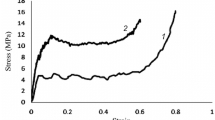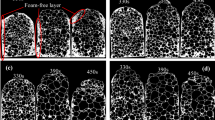Abstract
Aluminium foams have become popular because of their properties such as high stiffness combined with very low density. The aluminium foams are being used in many applications like automobiles, railways, aerospace, ship building, household applications etc. The development of foam with consistent quality and study of foam structure–property relation is important for both scientific and industrial applications. Metallic foams are commonly produced using hydride and carbonates foaming agents. However carbonate foaming agents are safer to handle than hydrides and produce aluminum foam with a fine, homogenous cell structure, low cost and easily available. The number of pores per inch and relative density of the foam play an important role on their physical and mechanical properties. Hence it is very important to investigate effect of grain size of calcium carbonate foaming agent on pores per inch and relative density. The present work deals with the effect of grain size of the calcium carbonate forming agent on the physical properties of an eutectic Al–Si alloy closed cell foam. The foam was produced with different grain size of calcium carbonate (150, 106, 75, 53 µm) as a foaming agent. The pores per inch and density of the foam produced with different grain size of calcium carbonates as foaming agent are determined. Relative density is in the range of 0.21–0.34, pores per inch is in the range of 11–20 for the produced eutectic Al–Si alloy closed cell foam. It is observed that as grain size of calcium carbonate used for production of aluminium foam increases, the number of pores per inch decreases, relative density decreases and porosity increases.




Similar content being viewed by others
References
Gui M C, Wang D B, Wu J J, Yuan G J, and Li C G, Mater Sci Eng A 286 (2000) 282.
Gibson L J, and Ashby M F, Cellular Solids, Structure and Properties, 2nd Edition, Cambridge University Press, Cambridge (1999).
Ashby A G, Evans N A, Fleck L J, Gibson J W, Hutchinson M F, and Wadley H N G, Metal Foams: A Design Guide, Butterworth Heinemann, Oxford (2000).
Kevorkijan V, Low cost aluminium foams made by CaCO 3 particulates, Scientific paper, UDC:549.74.621.762, Association of Metallurgical Engineers of Serbia AMS, MJoM 16 (2010) 205.
Gergely V, Curran D C, and Clyne T W, Compos Sci Technol 63 (2003) 2301.
Bryant J D, Kallivayalil J A, Crowley M D, Joseph G R, Wieserman L F, Wilhelmy D M, Boren Jr., and William E, US Patent 7452402, 2008, Method for producing foamed aluminum products by use of selected carbonate decomposition products, US patent Issued on November 18, 2008.
Acknowledgments
The authors would like to thank and acknowledge Visvesvaraya Technological University, Belagavi, Karnataka, India, for the financial support for this Project, under University Research Grant Scheme [Ref. No. VTU/Aca./2009-10/A-9/11476, Dated: 02-01-2010].
Author information
Authors and Affiliations
Corresponding author
Electronic supplementary material
Below is the link to the electronic supplementary material.
Rights and permissions
About this article
Cite this article
Praveen Kumar, T.N., Venkateswaran, S. & Seetharamu, S. Effect of Grain Size of Calcium Carbonate Foaming Agent on Physical Properties of Eutectic Al–Si Alloy Closed Cell Foam. Trans Indian Inst Met 68 (Suppl 1), 109–112 (2015). https://doi.org/10.1007/s12666-015-0631-8
Received:
Accepted:
Published:
Issue Date:
DOI: https://doi.org/10.1007/s12666-015-0631-8




